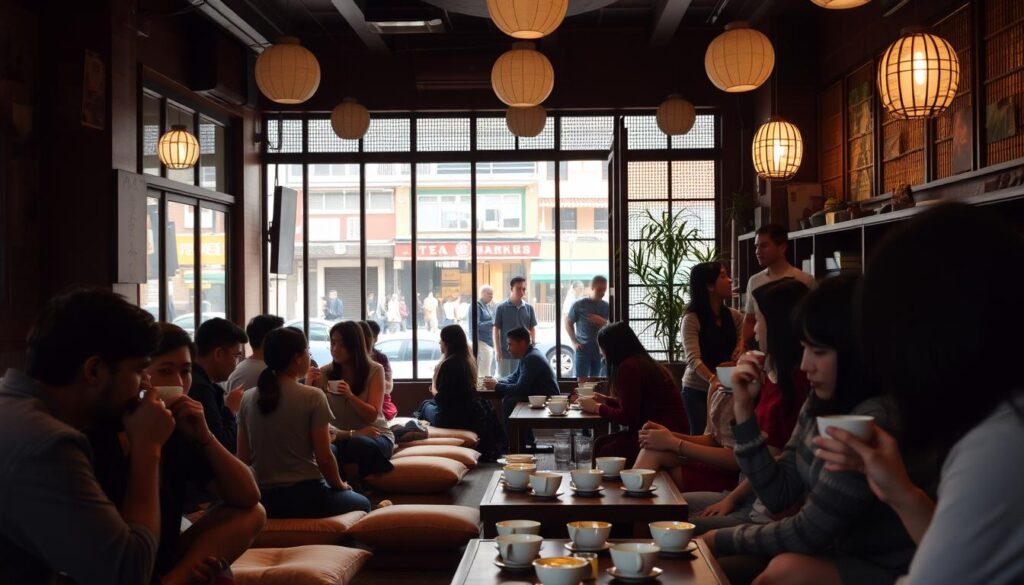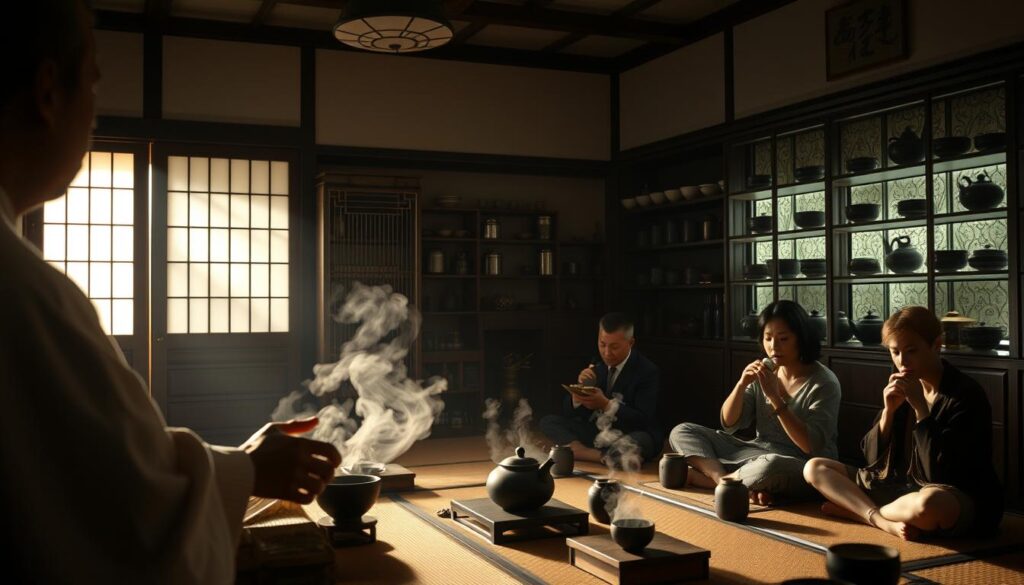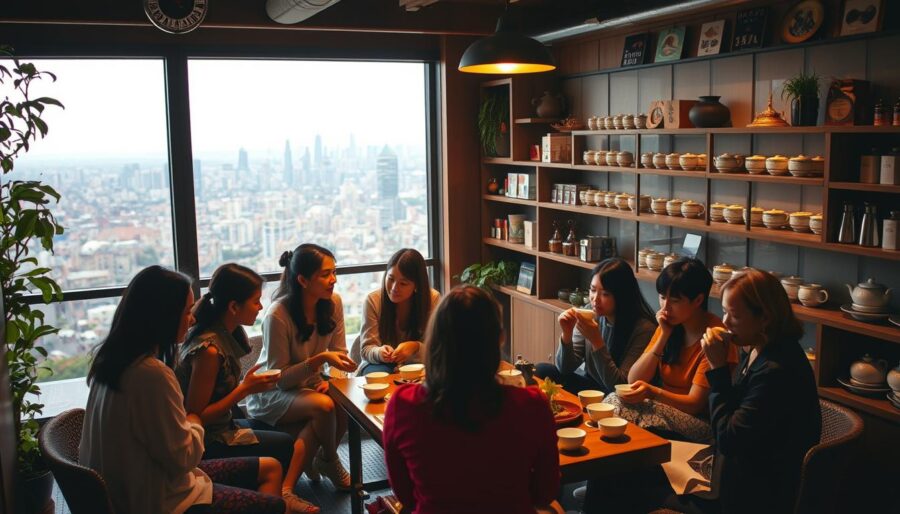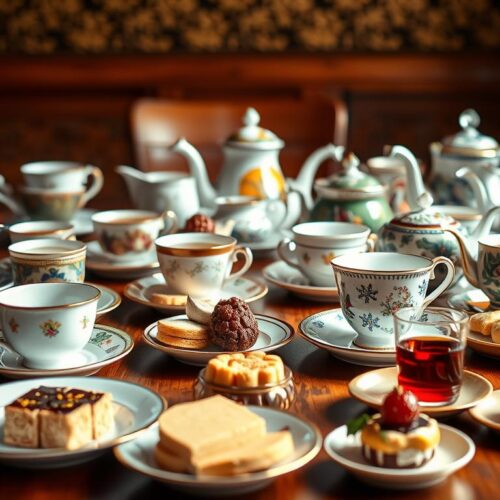Welcome to the colorful world of tea houses, pivotal for community life worldwide. These aren’t just places for tea but vital centers where traditions thrive. Each spot, from Japan’s quiet tea rooms to China’s lively tea houses, is important to its culture.
They are where friends and family come together, building connections and a feeling of community. By diving into their history and varied customs, we see their role in global tea culture. Let’s explore this engaging world and see how tea houses bond communities and celebrate cultural diversity.
Introduction to Tea House Culture
Tea house culture is a beautiful mix from many world traditions. It celebrates the rituals of tea drinking, mixing quiet thought with lively talks. Visiting tea rooms means enjoying calm and friendship together.
When you learn about tea rooms, you find places made for rest and deep talks. These spots smell of tea and show off each serving with care. Here, people come to drink tea, share stories, and laugh. Knowing about tea house culture teaches you its history and present importance.
The Role of Tea Houses in Different Cultures
Tea houses play a crucial role in many cultures, each with its own traditions. In Japan, they are more than places to drink tea. They are peaceful retreats for mindfulness and deep cultural rituals. Visitors find peace, connecting deeply with the ceremony and calmness around them.
In China, tea houses focus on bringing people together. They are warm and welcoming, perfect for friends and families to relax. The act of sharing tea fosters connections and lively chats, making tea rooms central to the culture.
Western tea culture has evolved, mixing traditional values with modern life. Cafés, drawing inspiration from tea houses, offer both comfort and a nod to their roots. They provide a welcoming space for those looking to unwind or connect with others.
| Culture | Characteristics of Tea Houses | Cultural Significance |
|---|---|---|
| Japan | Serene environments, ritualistic tea ceremonies | Harmony, aesthetics, and mindfulness |
| China | Communal spaces, focus on hospitality | Connection, warmth, and conversation |
| Western | Modern cafés with traditional roots | Blend of old and new, relaxation, and socializing |
Social Aspects of Tea Houses
Tea houses are key places for social bonding. They offer a cozy atmosphere where everyone is welcome. Here, friends meet, and even strangers can easily mingle over tea.
Tea houses do more than just serve tea; they build connections. Every visit, whether with friends or family, makes community ties stronger. Special events like poetry readings or tea tastings add to this community feeling.

Tea drinking rituals in these places are important in many cultures. Each event shows different customs, making every visit unique. Through these moments, community bonds grow strong.
| Tea House Activities | Social Impact |
|---|---|
| Tea Tasting Events | Encourages learning and sharing of knowledge about different teas |
| Book Clubs | Fosters literary discussions and builds friendships |
| Art Exhibitions | Cultivates appreciation for local artists and community talent |
Tea houses are all about the joy of meeting and talking. They turn simple meetings into deep friendships. By taking part in tea house culture, you’re joining a community that enriches everyone’s life.
Tea Varieties: The Heart of the Menu
The teas we offer are central to our tea house’s unique vibe and identity. Choices like Japanese matcha, Chinese oolong, or English breakfast tea connect us to different cultures. A great tea menu makes the whole experience better for everyone.
Our menu features a wide range of teas, each prepared in its own way. Green teas such as sencha have a fresh, grassy flavor. Black teas are bolder and can be enjoyed with milk or lemon. We pick only the best tea leaves to lift up your tea experience.
Knowing about each tea’s background makes your tea time more special. It lets you learn about the traditions behind them. A well-thought-out tea menu takes you on a journey, helping you find new favorites and understand their stories.
The Atmosphere of a Tea House
The atmosphere of a tea house is crucial to your experience. It provides a calm environment for you to enjoy your time. Elements like traditional decor, soft lighting, and comfy seats help create a peaceful space. This space lets you leave behind daily stress.
Tea room designs show the culture they come from. Japanese tea gardens, for example, are simple and peaceful. They help you think and relax. But, Chinese tea houses have fancy decorations that add to the visual experience. Each design helps make a special atmosphere just for enjoying tea.
Entering a tea house, you’ll notice wonderful smells and sounds. You might hear quiet talk or relaxing music. This design helps make a calming space. It lets you enjoy tea drinking even more.
| Design Element | Japanese Tea House | Chinese Tea House |
|---|---|---|
| Decor Style | Minimalist and Natural | Ornate and Decorative |
| Lighting | Soft Natural Light | Warm, Ambient Light |
| Seating Arrangement | Simple Mats and Low Tables | Tables with Chairs |
| Aroma | Fresh Herbs and Subtle Fragrances | Rich Teas and Scented Flowers |
Understanding tea house ambiance highlights different cultures and tea room artistry. It makes you appreciate the experience even more.
The Rituals of Tea Drinking
Tea-drinking rituals are deep-rooted in history, varying greatly across cultures. They turn the simple act of drinking tea into an art. They focus on beauty, mindfulness, and bringing people together. The Japanese tea ceremony, Chanoyu, is a famous example. It shows the importance of preparation and living in the moment.
Moroccan mint tea, on the other hand, is all about hospitality and friendship. This sweet green tea is often called “Moroccan whiskey.” The way it’s poured is a key part of the ritual. It turns making tea into a social event.
Taking tea can mean different things in different places. It might be about peace during a Japanese ceremony or joy at a Moroccan gathering. But all these rituals share one thing: they make drinking tea a way to connect with others.

Culinary Pairings with Tea
Exploring tea pairings opens up a new world of taste, where each sip and bite uplifts the other. Many cultures have their special tea and food matches. Like, English afternoon tea paired with scones, which brings out the tea’s flavor. Or, Moroccan mint tea served with sweet pastries to mix minty freshness with sugary taste.
Think about how the tea and food flavors work together. For instance, chamomile tea goes well with a lemon tart or vanilla cookies. But, strong black teas can handle rich, spicy meals, like Indian curries.
- Green tea with sushi or light salads
- Oolong tea with roasted meats and grilled vegetables
- White tea with delicate pastries or fruit
- Black tea with chocolate desserts or rich cheeses
Finding the right tea and food match can turn a simple meal into something unforgettable. It lets you dive into various food cultures across the globe.
The Business of Tea Houses
Running a tea house today mixes challenges with big chances. People want quality and real tea experiences more than ever. Knowing the tea world inside and out is key to winning.
Good tea is essential, and so is where it comes from. Happy customers and a trusted brand depend on both. Work with suppliers who care about the planet and the quality like you do.
Social media is a game-changer for getting the word out. Use Instagram or Facebook to show off what makes your tea special. Share cool tea facts, peeks behind the scenes, and stories to make fans feel at home.
Learning from successful tea houses can shine a light on what works. For example, those focusing on community events often do well. Offering classes or tastings can help people feel connected to your brand.
| Business Aspect | Importance | Example Strategy |
|---|---|---|
| Sourcing Quality Products | Builds brand reputation | Partner with sustainable farms |
| Marketing via Social Media | Engages and attracts customers | Share unique tea recipes on Instagram |
| Community Engagement | Strengthens customer loyalty | Host tea tasting events |
The Health Benefits of Tea
Exploring the health benefits of tea uncovers lots of advantages that boost your wellness. Tea isn’t just about its tasty flavors and smells. It also has antioxidants that help keep you healthy. Drinking tea regularly can make your heart healthier, keep you hydrated, and build a stronger immune system.
Different teas have their own special benefits. Green tea, for example, is great for speeding up your metabolism and helping you manage your weight. Black tea can make your gut healthier and lower your cholesterol. Herbal teas like chamomile and peppermint are good for calming you down and helping with stomach issues. Adding different teas to your diet can really improve your health.
Taking tea seriously as part of your health routine is a good idea. Trying new types of tea and learning about their health benefits can make your tea journey more enjoyable. It helps you stay committed to staying healthy.
Tea Appreciation and Education
Exploring the tea world is more than tasting. It’s about committing to learn about tea. Knowing the types of tea and where they come from makes enjoying tea better. Learning includes how to brew it and its cultural importance, which makes it more fun.
Many tea houses have workshops, tastings, and courses for tea learning. These activities let you dive deeper and change how you see tea. Joining these events makes you know more and connects you with tea lovers, creating community.
Learning about tea leads to discovering new tastes and traditions. As you taste more, you’ll notice the different flavors, smells, and textures. Spending time to learn about tea means every cup is more enjoyable, turning it into a deep cultural journey.
Future Trends in Tea House Culture
The culture around tea houses is changing as society does. The outlook for tea houses is promising. This is thanks to new trends reflecting our desire for sustainability and innovation. A key change is the shift towards getting tea in a way that’s good for the planet. People now want to know where their tea comes from. This improves the tea’s quality and builds a community focused on caring for the Earth.
New and exciting flavors are making their way into tea culture. Fusion teas, which mix old styles with new, are catching on. These new blends please a wide range of tastes. They’re especially appealing to young people who love trying different things.
Technology will also shape the future of tea houses. Things like apps for ordering and online tea tasting will make visits more fun. When you go to a tea house, you’ll see how old traditions and new tech can work together. This blend helps these special places continue to be spots where people can come together in fresh, enjoyable ways.




